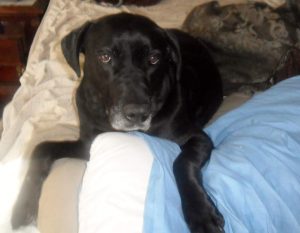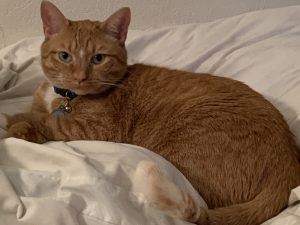Pets and PH: Furry Friends Are PHamily, Too

It doesn’t take long after a pulmonary hypertension (PH) diagnosis to realize the disease will have an influence on the patient, family members, and yes, even the pets.
Our furry friends who snuggle with us when we are tired, comfort us when we are feeling down, and appear concerned or antsy when we are sick can sense and will react to the unsettling emotional and physical vibes prompted by PH.
I have heard people refer to their pets as fur babies. It’s a fitting term of endearment, because these special family members are cute and innocent, and like toddlers, they need close supervision. Therefore, for the safety of you and your pets, take extra precautions when PH medications, treatments, and medical equipment become part of the household routine and décor.
When my son Cullen was diagnosed with PH, he was placed on triple therapy that included continuous intravenous Flolan (epoprostenol GM). Our senior dog Daisy needed no training on how to behave around Cullen’s central line, Flolan equipment, and home oxygen concentrator. She intuitively knew these things were important and that she needed to be gentle around him.
We also had Rosie, a black Labrador retriever puppy. She was the size of a small pony and not yet trained to control her hyperactive energy. Rosie came close to giving us a crash course on the importance of pet safety around our PH family member.
Sleepy-eyed Cullen was heading downstairs one morning without properly tucking his central line tubing into his clothing and medical backpack. Excited to see him, Rosie jumped around at the top of the stairs and got tangled in Cullen’s central line.
Hearing the commotion, I ran to Cullen’s aid, and with all my might, struggled to hold the dog still to free her before she could run down the steps, taking Cullen with her, and possibly pulling the central line out of his chest.
I managed to safely untangle them, but the fear we experienced lingered for a long time, not just with us, but with the dog as well. She knew something bad had happened. It took more training, but eventually, she turned into a gentle giant whenever she was around Cullen.
Even small fur balls need to be watched closely around medical equipment. I shared in a previous column that on Cullen’s 13th birthday, he ended up in the hospital because his hamster bit a hole in his central line. We suspect that Russell, the hamster, got a tiny dose of Flolan, because he appeared lethargic for a while.
Luckily, by the next day, Cullen’s line was repaired, and Russell was running his hamster wheel like a champ. It was another pet safety lesson well learned: Keep tubes and wires clear from the mouths of curious critters.
Over the years, beloved pets have passed, and now we own Mellow, the Jack Russell, a husky named Harmony, and Willie the orange tabby cat.
Cullen lived with PH for six years, and is now almost seven years along after his heart and double-lung transplant. We are pros at efficiently and safely organizing and storing medical supplies and medications. However, we can still make mistakes, no matter how much experience and care is put into preventing them.
Recently, I let my guard down with my own asthma inhaler. Tired and feeling unwell, I thoughtlessly placed it on my nightstand instead of in the drawer. Suddenly, I woke to a loud hissing noise and a frightened Harmony.
The inhaler must have looked like an interesting toy to her puppy eyes. It was all fun and games until she punctured a hole in it. The few puffs of medicine it contained was enough to make her throw up a few times.
We kept her well hydrated and watched for worsening symptoms as our veterinarian instructed. Luckily, she recovered quickly, and my level of caution regarding medications has increased.
This includes preventive measures like keeping the cat out of the room when organizing Cullen’s weekly pill box. Willie is very attracted to the scent of certain medications and supplements. He will relentlessly try to get at them like cat nip, so we are extremely careful not to give him the opportunity.
Cullen adopted his Jack Russell after recovering from transplant. Since she was a puppy, Mellow has remained the perfect emotional support dog. She is both instinctively gentle and protective.
To make sure our furry friends are healthy and safe for Cullen to be around, we follow up with wellness checks and keep them up to date on their pet vaccinations.
It all sounds like a lot of work, but we believe the therapeutic benefits of owning a pet are well worth the level of responsibility they require.
***
Note: Pulmonary Hypertension News is strictly a news and information website about the disease. It does not provide medical advice, diagnosis, or treatment. This content is not intended to be a substitute for professional medical advice, diagnosis, or treatment. Always seek the advice of your physician or other qualified health provider with any questions you may have regarding a medical condition. Never disregard professional medical advice or delay in seeking it because of something you have read on this website. The opinions expressed in this column are not those of Pulmonary Hypertension News or its parent company, Bionews, and are intended to spark discussion about issues pertaining to pulmonary hypertension.












Jill Gerrie
Ha! I had to laugh... I got out of the hospital last week after getting a new Hickman after my dog got tangled up in my tubing and pulled it partially out of my chest. I will be much more careful in the future! The threat is real ;)
Colleen Steele
Thank you for reading the column, Jill. The threat is very real! I've heard stories from other IV users about pet interference! Thankfully they usually turn out as not so funny in the moment but a little humorous after the fact.